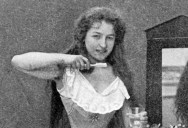Here’s How People Cleaned Their Teeth Before Toothpaste

Now, you might be thinking “they probably just didn’t know that cleaning them was important,” but that’s definitely not true.
Personally, I think that even without knowledge about bacteria people would have wanted to get rid of that annoying film.
And it turns out that human beings from the prehistoric world until the invention of toothpaste did have their practices – and some of them probably even worked.
Long-ago people did suffer from more tooth decay and gum disease than we do, but there is evidence that they at least tried to develop decent dental practices.

In fact, the earliest known indication of dental care is found in the skeletal mouth of a 130,000 year-old Neanderthal. The molars show evidence of being scraped by some kind of toothpick, possibly made from a bit of bone or stiff grass.
Like modern day floss, these were likely used to clean bits of food from between their teeth.
The earliest known dental patient is recorded 14,000 years ago in an Italian rock shelter. They appear to have suffered from tooth decay, and had the rotten component of at least one tooth scraped away using a sharp stone tool.
Around 5000 BCE, the ancient Egyptians developed the world’s first toothpaste. The powdery substance was made from ash from charred oxen hooves, eggshells, myrrh, and pumice.

If it sounds abrasive, that’s because it likely was – but it also probably did a decent job of removing debris.
The Persians added burnt snail and oyster shells, herbs, and honey to the mix.
The Romans tossed in charcoal and tree bark, hoping to reduce that annoying bad breath.
Egyptian and Babylonian tombs both contained toothbrushes dating back to around 3500 BCE. They were hardly more than twigs that had been chewed to fray the fibers into “bristle,” but were a good effort that likely made a difference.
The trees the twigs were taken from – like neem and Salvadora persica – also have antimicrobial properties that could have slowed the spread of bacteria.
In turn, this could have reduced tooth decay and gum disease.
The earliest known recognizable toothbrush was found in China during the Tang Dynasty, between the 7th and 10th centuries BCE.

They used boar hair for the bristles and bamboo or bone for the handle, and perhaps unsurprisingly, weren’t all that popular.
Possibly because of the pig hair.
We’ll never know.
I bet you’re happier now for modern dentistry!
If you found that story interesting, learn more about why people often wake up around 3 AM and keep doing it for life.

Sign up to get our BEST stories of the week straight to your inbox.




